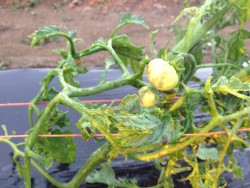Responding to Hailstorms
Crystal Stewart-Courtens, Extension Vegetable Specialist
Eastern New York Commercial Horticulture

The second precaution which will help in the event of hail is the application of a preventative fungicide such as copper or chlorothalonil. Although these products are not rain-fast, we have found that they still help reduce incidence of fungal and bacterial infections from hailstorms.
After hail: The damage left by hail varies tremendously based on the size and shape of the hailstone, the wind velocity of the storm, and the duration of the hail event. Deciding how to respond is really case-by-case. Two farms right next to each other can experience very different levels of damage. However, there are some rules of thumb that generally hold true.
1) Cucurbits are going to look really bad but are likely to recover. Those huge leaves tend to tatter very dramatically during hail, and can look absolutely awful. However, the leaves can also help to protect the growing points, which largely determine whether a plant will recover or not. Generally cucurbits that are old enough to have an established root system and have intact growing points will be able to generate new leaves very quickly and will begin producing fruit within a couple of weeks. To facilitate this process, give some extra nitrogen through the drip system. Pick and remove summer squash fruit that were damaged by hail if you can.
2) All plants will benefit from a protective fungicide application. After hail, plants have hundreds of small (or large) wounds which leave them extremely vulnerable to diseases. As soon as you can get on the field, apply a protectant such as copper or chlorothalonil (copper will protect from bacterial and fungal diseases so is the better option), even if you applied one before the storm. This will help prevent infection while the plant heals up those wounds.
3) Incidence of bacterial rot in onions is going to increase. We tend to see many more issues with onion storage following hail. Copper may help somewhat, but results have been mixed to poor.
Deciding what to do with tomatoes can be tricky. According to Dr. Reiners, determinate varieties suffering from moderate to severe damage (think of snapped branches and stripped leaves-Image 1) are most likely to be lost causes because by the time they recover they will practically be at the end of their lives. It is best to pull plants at this threshold out. Indeterminate tomatoes have a better chance of recovering from hail. All fruit which was hit will be relegated to seconds at the very best. Damage can vary greatly by variety because of the differences in canopy cover, so assess each separately. Last year we saw Primo Reds that were a complete loss next to Amish Paste tomatoes which were about 80% ok.
On plants with heavy foliage such as corn and sweet potatoes, a foliar feeding including nitrogen and some micronutrients may be beneficial. Remember that you have to have intact foliage to spray for this to be effective.
Once you have done everything you can to clean up and protect your plants, it is often best from a mental health standpoint to walk away for a few days up to a week. There is a small period of time where this is nothing more to do but let the plants recover. Nice time for a mini vacation. Really.
As always, if you would like help deciding what to do after hail or any other weather event, please give us a call.

Upcoming Events
How to Obtain a Pesticide Applicator License
December 17, 2025
Thinking about becoming a certified pesticide applicator in New York, but aren't sure where to start? Join DEC representative Kenneth Klubek for a discussion on who needs to become a certified pesticide applicator, certification types, examination procedures, and recertification. Participants will have ample opportunity to ask questions during the program.
Ag Labor Road Show IX
December 1, 2025 : Save the Date! - Ag Labor Roadshow Webinar 1
In addition to the in-person Ag Labor Roadshow program in our region on December 9, two webinars are scheduled for December 1 and December 22. Each webinar will focus on different program content that is different from the in-person sessions. These webinars are an added benefit to program registration.
December 9, 2025 : Save the Date - Ag Labor Road Show In-Person Event (Greenwich, NY)
Greenwich, NY
The Roadshow delivers essential updates on labor law, regulations, and workforce best practices—tailored for farm owners, managers, and ag service providers. Sessions also focus on practical strategies to boost communication, strengthen retention, and build a positive workplace culture.
The in-person session for Eastern NY is December 9 - Elks Lodge, Greenwich, NY - full day in person session
Additional in-person sessions are:
December 10 - Hilton Garden Inn, Watertown, NY, December 17 - Cornell AgriTech, Geneva, NY, December 18 - Genesee Community College, Batavia, NY
December 22, 2025 : Save the Date! - Ag Labor Roadshow Webinar 2
In addition to the in-person Ag Labor Roadshow program in our region on December 9, two webinars are scheduled for December 1 and December 22. Each webinar will focus on different program content that is different from the in-person sessions. These webinars are an added benefit to program registration.
2026 Winter Cut Flower Webinar Series
January 6, 2026 : Session 1: Cut Flower Cost Calculator Updates and Woody Cuts
Session 1: Cut Flower Cost Calculator Updates and Woody Cuts
January 13, 2026 : Session 2: Perennials and Industry Trends
Session 2: Perennials and Industry Trends
January 20, 2026 : Session 3: Anaerobic Soil Disinfestation and Biochar
Session 3: Anaerobic Soil Disinfestation and Biochar
January 27, 2026 : Session 4: Beneficial Insects and Propagation Techniques
Session 4: Beneficial Insects and Propagation Techniques
February 3, 2026 : Session 5: Fungal and Insect Pests and Market Trends
Session 5: Fungal and Insect Pests and Market Trends












































